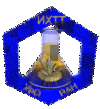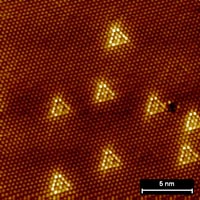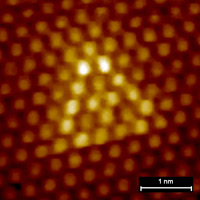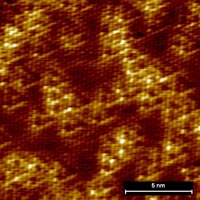|
|
| 14.08.2018 |
Site- and spin-dependent coupling at the highly ordered h-BN/Co(0001) interface
D.Yu. Usachov, A.V. Tarasov, K.A. Bokai, V.O. Shevelev, O.Yu. Vilkov, A.E. Petukhov, A.G. Rybkin, I.I. Ogorodnikov, M.V. Kuznetsov, M. Muntwiler, F. Matsui, L.V. Yashina, C. Laubschat, D.V. Vyalikh
Phys. Rev. B, V. 98, P. 195438. DOI
ABSTRACT. Using photoelectron diffraction and spectroscopy, we explore the structural and electronic properties of the hexagonal boron nitride (h-BN) monolayer epitaxially grown on the Co(0001) surface. Perfect matching of the lattice parameters allows formation of a well-defined interface where the B atoms occupy the hollow sites while the N atoms are located above the Co atoms. The corrugation of the h-BN monolayer and its distance from the substrate were determined by means of R-factor analysis. The obtained results are in perfect agreement with the density functional theory (DFT) predictions. The electronic structure of the interface is characterized by a significant mixing of the h-BN and Co states. Such hybridized states appear in the h-BN band gap. This allows to obtain atomically resolved scanning tunneling microscopy (STM) images from the formally insulating 2D material being in contact with ferromagnetic metal. The STM images reveal mainly the nitrogen sublattice due to a dominating contribution of nitrogen orbitals to the electronic states at the Fermi level. We believe that the high quality, well-defined structure and interesting electronic properties make the h-BN/Co(0001) interface suitable for spintronic applications.
|
| 03.04.2018 |
Photoelectron diffraction and holography studies of 2D materials nad interfaces
Mikhail V. Kuznetsov, Ilya I. Ogorodnikov, Dmitry Yu. Usachov, Clemens Laubschat, Denis V. Vyalikh, Fumihiko Matsui, and Lada V. Yashina
J. Phys. Soc. Jpn., V. 87, P. 061005. DOI
ABSTRACT. Photoelectron diffraction (XPD) and holography (XPH) are powerful spectroscopic methods that allow comprehensive exploration and characterization of certain structural properties of materials, in particular those of 2D systems and interfaces. Recent developments in XPD and XPH are especially impressive when they are applied to partially disordered systems such as intercalation compounds, doped graphene, buffer layers or adsorbates and imperfectly ordered germanene and phoshporene. In our brief review, we sum up the advances in XPD and XPH studies of 2D materials and discuss the unique opportunities granted by these two interrelated methods.
|
| 21.02.2018 |
Electron-phonon coupling in graphene placed between magnetic Li and Si layers on cobalt
Dmitry Yu. Usachov, Alexander V. Fedorov, Oleg Yu. Vilkov, Ilya I. Ogorodnikov, Mikhail V. Kuznetsov, Alexander Grüneis, Clemens Laubschat, and Denis V. Vyalikh
Phys. Rev. B, V. 97, P. 085132. DOI
ABSTRACT. Using angle-resolved photoemission spectroscopy (ARPES), we study the electronic structure and electron-phonon coupling in a Li-doped graphene monolayer decoupled from the Co(0001) substrate by intercalation of silicon. Based on the photoelectron diffraction measurements, we disclose the structural properties of the Si/Co interface. Our density functional theory calculations demonstrate that in the studied Li/graphene/Si/Co system the magnetism of Co substrate induces notable magnetic moments on Li and Si atoms. At the same time graphene remains almost nonmagnetic and clamped between two magnetically active atomic layers with antiparallel magnetizations. ARPES maps of the graphene Fermi surface reveal strong electron doping, which may lead to superconductivity mediated by electron-phonon coupling (EPC). Analysis of the spectral function of photoelectrons reveals apparent anisotropy of EPC in the k space. These properties make the studied system tempting for studying the relation between superconductivity and magnetism in two-dimensional materials.
Impact factor 3.836
|
|



.jpg)
.jpg)

